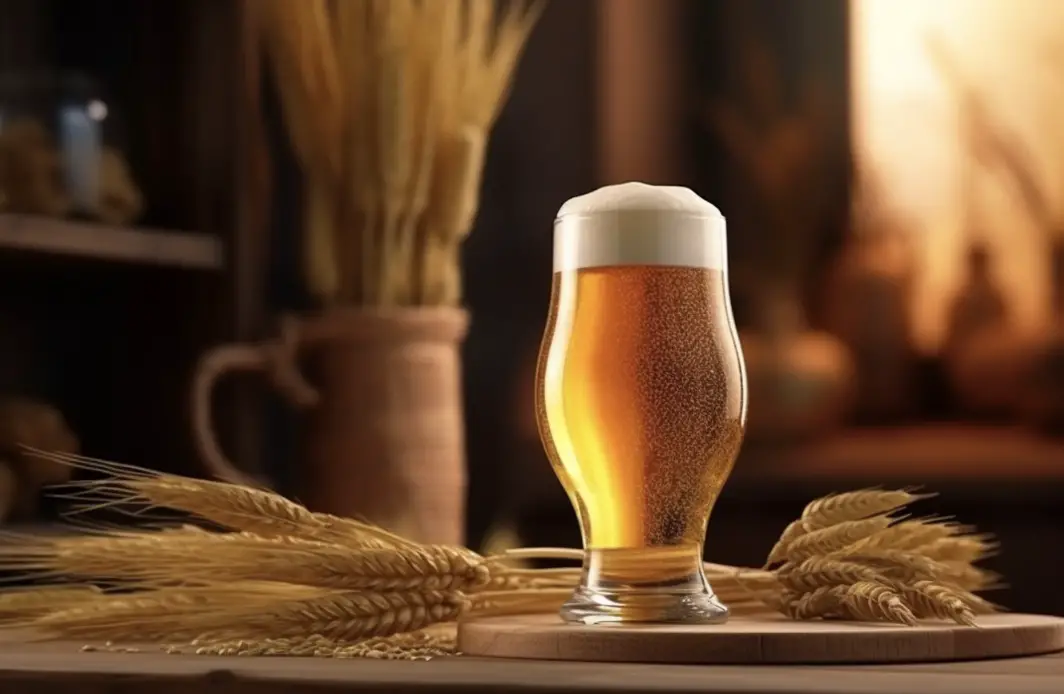Ageing mead is a crucial step in the brewing process that can significantly enhance its flavor and complexity.
By allowing the mead to mature over time, the desired flavors have a chance to blend and develop, while any unwanted off flavors can dissipate.
There are various methods and containers for ageing mead, including oak barrels, bottles, and carboys. In this blog section, we will explore the importance of ageing mead, common ageing methods, and the pros and cons of different containers for ageing.
I. Why Age Mead?
Aging mead is a popular practice among enthusiasts and brewers for several reasons. The aging process allows the flavors and aromas of the mead to develop and mature over time, resulting in a more complex and refined beverage. Here are a few key reasons why you should consider aging mead:
The Chemical Processes that Occur During Aging
During the aging process, several chemical reactions take place that contribute to the transformation and improvement of the mead. These include:
- Oxidation: Oxygen exposure during aging can help soften harsh tannins and improve overall flavor.
- Polymerization: Phenolic compounds in the mead can undergo polymerization, resulting in smoother and more balanced flavors.
- Mellowing of Alcohol: Over time, the alcohol in the mead can mellow, leading to a smoother and less harsh taste.
How Aging Enhances Flavors and Aromas
Aging mead can lead to the development of complex flavors and aromas that are not present in freshly-made mead. Some benefits of aging include:
- Enhanced Smoothness: Aging gives mead a smoother and more rounded mouthfeel, reducing any harshness in the flavors.
- Mellowing of Acidity: Acidity levels in the mead can mellow over time, resulting in a more balanced and pleasant taste.
- Integration of Flavors: The various components of mead, such as honey, yeast, and added ingredients, can blend together more harmoniously during the aging process.
By allowing mead to age, you can unlock its full potential and enjoy a more nuanced and enjoyable drinking experience. [1][2][3][4]
II. Where to Age Mead?
When it comes to aging mead, there are several options to consider. Each method has its own unique effects on the flavor and characteristics of the mead. Here are the main ways to age mead:
Oak Barrel Aging and Its Effects on Mead
Aging mead in oak barrels can add complexity and depth to the flavor profile. The oak imparts flavors such as vanilla, coconut, and clove, while also adding tannins and mouthfeel. This method is often used for wines and bourbons and can provide similar benefits to mead.

Aging in Bottles and Its Benefits
Bottle aging mead allows for the flavors to mellow and blend over time. It also allows for consistent flavor development across all bottles. This method is convenient and can be done at home.

Aging in Carboys and its Pros and Cons
Using carboys for aging mead allows for bulk aging, which can result in consistent flavors throughout the entire batch. However, it requires more space and may tie up carboys for an extended period of time.

Consider the options and choose the aging method that best suits your preferences and resources. Remember, aging mead takes time, patience, and experimentation to achieve the desired results. [5][6][7][8]
III. How to Age Mead?
When it comes to aging mead, proper storage conditions are essential to ensure the development of desirable flavors and aromas. Here are some guidelines for aging your mead:
Proper Storage Conditions for Aging Mead
– Keep the mead in a cool, dry place away from direct sunlight.- Maintain a stable temperature between 45 to 65 degrees Fahrenheit.- Store the mead in a sealed container to prevent oxidation.- Avoid exposure to vibrations or excessive movement.
Monitoring and Maintaining Ideal Aging Conditions
– Regularly check the temperature and humidity levels in the storage area.- Ensure that there are no temperature fluctuations that could negatively affect the mead.- Use a thermometer and hygrometer to monitor the conditions.
The Role of Oxygen Exposure in Aging
While some oxygen exposure during aging can contribute to the development of flavors, excessive exposure can lead to oxidation and spoilage.
If aging in a carboy, ensure that there is minimal headspace to minimize oxygen contact. When using oak barrels or bottles, ensure proper sealing to prevent excessive oxygen exposure.
By following these guidelines, you can create optimal conditions for aging your mead and achieve the desired flavor profile. [9][10][11][12][13][14]
IV. How Long to Age Mead?
Factors that Influence Aging Duration
The aging duration of mead can vary depending on several factors, including:
- Alcohol content: Meads with higher alcohol content generally require longer aging periods to develop their full flavors and mellow out any harshness.
- Recipe and ingredients: Certain ingredients, such as fruits or spices, may require more time to fully integrate and enhance the flavor profile of the mead.
- Personal preference: Some mead enthusiasts enjoy the taste of young meads, while others prefer the complex flavors that come with extended aging.
Alcohol content plays a significant role in the aging process. Meads with higher alcohol content generally require longer aging periods. This is because the higher alcohol content can contribute to harsh flavors and a hot or “burning” sensation when the mead is young. With time, the alcohol mellows, allowing other flavors to shine through. Meads with lower alcohol content may not require as much aging to reach their optimal flavor profile.
The recipe and ingredients used in the mead can also influence the aging duration. Ingredients such as fruits or spices may require more time to fully integrate and enhance the overall flavor profile of the mead. Fruits may need time to release their flavors and undergo fermentation, while spices may need time to infuse and mellow. The specific recipe and ingredients used will determine how long the mead should age for optimal results.
Personal preference is another important factor in determining the aging duration. Some mead enthusiasts enjoy the taste of young meads, which can have vibrant and fresh flavors. These meads may not require extensive aging and can be consumed relatively soon after fermentation.
On the other hand, others prefer the complex and nuanced flavors that come with extended aging. These individuals may choose to age their mead for several years to allow the flavors to fully develop and integrate.
Determining the Optimal Aging Time for Different Mead Varieties
The optimal aging time for different mead varieties can vary. Here are some general guidelines:
- Traditional meads: Traditional meads, which consist primarily of honey, water, and yeast, typically benefit from at least 1 to 2 years of aging. This aging period allows the flavors to blend and any off-flavors resulting from fermentation to dissipate. It also provides an opportunity for the mead to develop a smooth and well-rounded taste.
- Fruit meads: Meads made with fruits, such as melons, berries, or citrus, may require longer aging periods. Fruit flavors can take time to fully develop and integrate with the base mead. In general, fruit meads benefit from aging for 2 to 5 years to achieve a harmonious balance between the fruit and honey flavors.
- Spiced meads: Meads that are spiced with herbs, spices, or botanicals often benefit from aging for at least 6 months to a year. This allows the spices to infuse into the mead, mellow out, and integrate fully, resulting in a more balanced and rounded flavor profile.
- Oak-aged meads: Meads aged in oak barrels can develop unique characteristics from the wood. The aging duration for oak-aged meads can vary depending on personal preference and the desired level of oak influence. Some mead makers may age their meads in oak barrels for 6 months to a year, while others may choose to age them for several years to achieve a more pronounced oak flavor.
It’s important to note that these guidelines are not set in stone, and individual variations exist. The optimal aging time for mead is subjective and may vary based on personal preferences.
It’s recommended to sample the mead periodically during the aging process to track its flavor development and determine when it reaches its peak flavor. This allows you to tailor the aging time to your specific tastes and preferences.
In summary, the aging duration of mead can vary depending on factors such as alcohol content, recipe and ingredients, and personal preference. Traditional meads generally benefit from 1 to 2 years of aging, while fruit meads may require 2 to 5 years.

Spiced meads may benefit from aging for at least 6 months to a year, and oak-aged meads can vary from 6 months to several years. Ultimately, the optimal aging time for mead is subjective and can be determined by regularly sampling the mead to achieve the desired flavor profile.
V. Conclusion
Aging mead is a personal choice that can greatly enhance its flavor and complexity. Whether you choose to age in an oak barrel, bottle, or carboy, it’s important to understand the benefits and considerations of each method. Here are some key takeaways on aging mead:
- Aging allows the flavors to mellow and blend, resulting in a smoother and more enjoyable taste.
- Oak barrels can add unique flavors and aromas to the mead, creating a rich and complex profile.
- Bottles and carboys offer convenience and control over the aging process, allowing you to sample the mead at different stages.
When deciding how long to age your mead, consider its alcohol content, sweetness, and desired flavor profile. It’s recommended to start sampling after at least 6 months to assess its development and determine the optimal aging period.
Choosing the Right Aging Method for Your Mead
The choice of aging method ultimately depends on your preferences and resources. Here are some factors to consider when choosing the right aging method for your mead:
- Oak barrels: Ideal for those seeking unique flavors and aromas. However, they require space, proper maintenance, and can be expensive.
- Bottles: Convenient for small batches and easier to control the aging process. They are readily available and cost-effective.
- Carboys: Ideal for larger batches and long-term storage. They provide stability and allow for bulk aging.
It’s important to remember that aging mead is subjective, and the best method for aging is the one that suits your taste and brewing goals.
Experimentation and sampling are key to finding your perfect balance of flavors and aging time [19][20][21][22]




